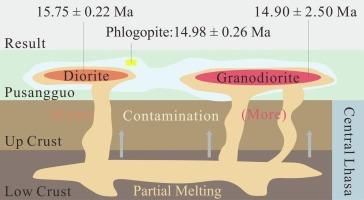The metallogenic age and geodynamic implications of the Pusangguo copper polymetallic deposit in central Tibet
IF 3.6
2区 地球科学
Q1 GEOLOGY
引用次数: 0
Abstract
The Pusangguo is a substantial skarn Cu–Pb–Zn polymetallic deposit in the Gangdese metallogenic belt, characterized by its large scale, high-grade mineralization, and metal diversity. The minerals traditionally utilized in geochronological studies typically exhibit higher closure temperatures than those recorded during mineralization processes, while comprehensive genetic correlations between the diorite and granodiorite remain underexplored. To constrain the age of mineralization and elucidate the deposit’s petrogenesis, we conducted an integrated study involving 40Ar/39Ar dating of hydrothermal phlogopite, as well as chronology, geochemistry and mineralogy analyses of the mineralized intrusions. Our results indicate that the diorite, granodiorite and hydrothermal phlogopite formed at 15.75 ± 0.22 Ma, 14.90 ± 2.50 Ma and 14.98 ± 0.26 Ma, respectively. The diorite and granodiorite exhibit adakitic signatures, characterized by high Sr contents, low Y and Yb concentrations, and elevated Sr/Y and (La/Yb) N ratios. Both rocks are enriched in light rare earth elements (LREEs) and large ion lithophile elements (LILEs), but depleted in heavy rare earth elements (HREEs) and high field strength elements (HFSEs). Notably, although they share similar Sr–Nd–Pb isotopic compositions, their εHf(t) values differ significantly, ranging from + 0.4 to + 3.0 in the diorite but –9.7 to –2.3 in the granodiorite. The 40Ar/39Ar age of phlogopite indicates that the mineralization occurred at approximately 14.98 Ma, thereby constraining the timing for the late hydrothermal activity. Both the diorite and granodiorite exhibit typical adakitic geochemical characteristics, and their magmas were derived from juvenile lower crust. However, compared with the diorite, the granodiorite exhibits a greater contribution from ancient crustal components in its magma source. The combined temporal and geochemical evidence supports a genetic model involving partial melting of juvenile mafic lower crust, rather than direct input from Neo-Tethyan slab break-off or high-K magma underplating.

浦三郭是冈底斯成矿带中规模大、成矿品位高、金属种类多样的大型矽卡岩型铜铅锌多金属矿床。传统地质年代学研究中使用的矿物通常表现出比成矿过程中记录的更高的闭合温度,而闪长岩和花岗闪长岩之间的综合成因相关性仍未得到充分研究。为了约束成矿年龄,阐明矿床的岩石成因,我们对热液云母进行了40Ar/39Ar定年综合研究,并对矿化侵入体进行了年代学、地球化学和矿物学分析。我们的研究结果表明,闪长岩、花岗闪长岩和热液金云母形成15.75 ±0.22 Ma 14.90±2.50 马和14.98±0.26 妈,分别。闪长岩和花岗闪长岩表现出高Sr、低Y、低Yb、高Sr/Y和(La/Yb) N特征。两种岩石均富集轻稀土元素(lree)和大离子亲石元素(LILEs),而缺乏重稀土元素(hree)和高场强元素(hfse)。值得注意的是,虽然它们具有相似的Sr-Nd-Pb同位素组成,但它们的εHf(t)值差异很大,闪长岩的εHf(t)值为 + 0.4 ~ + 3.0,花岗闪长岩的εHf(t)值为-9.7 ~ -2.3。辉云母40Ar/39Ar年龄表明成矿时间约为14.98 Ma,限制了后期热液活动的时间。闪长岩和花岗闪长岩均表现出典型的埃达质地球化学特征,其岩浆来源于幼年下地壳。与闪长岩相比,花岗闪长岩的岩浆源中古地壳成分的贡献更大。综合时间和地球化学证据支持一个成因模型,该模型涉及幼年基性下地壳的部分熔融,而不是新特提斯板块断裂或高钾岩浆底板的直接输入。
本文章由计算机程序翻译,如有差异,请以英文原文为准。
求助全文
约1分钟内获得全文
求助全文
来源期刊

Ore Geology Reviews
地学-地质学
CiteScore
6.50
自引率
27.30%
发文量
546
审稿时长
22.9 weeks
期刊介绍:
Ore Geology Reviews aims to familiarize all earth scientists with recent advances in a number of interconnected disciplines related to the study of, and search for, ore deposits. The reviews range from brief to longer contributions, but the journal preferentially publishes manuscripts that fill the niche between the commonly shorter journal articles and the comprehensive book coverages, and thus has a special appeal to many authors and readers.
 求助内容:
求助内容: 应助结果提醒方式:
应助结果提醒方式:


